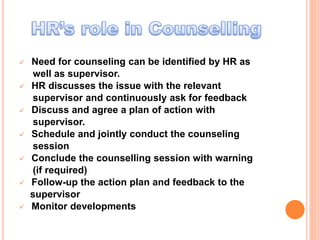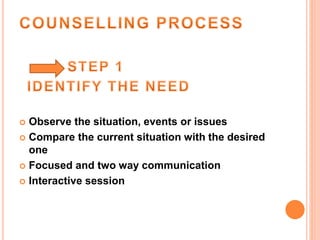Employee counselling
- 1. PRESENTATION ON EMPLOYEE COUNSELLING PRESENTED TO :- PRESENTED BY :- Dr.RAJUL BHARDWAJ RAHUL SAINI GURUKUL KANGARI UNIVERSITY HARIDWAR
- 2. EMPLOYEE COUNSELLING COUNSELLING COUNSELLING IS A THERAPEUTIC PROCESS OF PROVIDING HELP AND SUPPORT TO PEOPLE TO FACE AND SAIL THROUGH DIFFICULT TIMES IN LIFE. IT HELPS PEOPLE TO SEE THINGS FROM A DIFFERENT VIEWPOINT AND ENCOURAGE THEM TO DRAFT THEIR ACTION PLAN.
- 4. NEED FOR EMPLOYEE COUNSELLING AT WORKPLACE WHEN Unrealistic Targets Excessive Workload Absenteeism and Late Coming Lack of awareness of policies & procedures Performance Issues Slipping Deadlines Career Problems
- 6. Face to Face communication Conducted by Immediate Supervisor Starts with a verbal discussion Ends with draft plan of action First action step
- 7. Pre Penalization Conducted By Human Resource department Starts with a warning/letter Ends with draft plan of action Second action step (if developmental counselling fails)
- 8. Need for counseling can be identified by HR as well as supervisor. HR discusses the issue with the relevant supervisor and continuously ask for feedback Discuss and agree a plan of action with supervisor. Schedule and jointly conduct the counseling session Conclude the counselling session with warning (if required) Follow-up the action plan and feedback to the supervisor Monitor developments
- 9. EVALUATIVE – Make judgments based on what you have heard and suggest answers. SUPPORTIVE – Offer general sympathy. PROBING – Find out more information. REFLECTIVE – Try to feed back your listener’s perception of what has been said in order to check its accuracy. INTERPRETATIVE – Interpret what you have heard without checking the accuracy of what you have heard.
- 10. The best counselor uses a combination of reflective and probing responses as this encourages staff to think through a problem and come with own solution Ultimately, the best style is the one which suits your situation
- 12. Observe the situation, events or issues Compare the current situation with the desired one Focused and two way communication Interactive session
- 13. Select a suitable place and notify the time. Notify the concern members well in advance. Organize Information. Outline the session components. Plan your counselling strategy. Establish the right atmosphere.
- 14. Opening the session Discussing the issue Developing the plan of action Recording and closing the session
- 15. Support subordinates to implement their plan of action Review plan of action to determine if the desired results were achieved Amend the plan of action if required Measures after session include follow up counselling and informing the high-up.
- 16. Empathetic Respectful Warm Confidential Honest Attentive Listening Open Ended Unbiased Understandable Unhurried Authority
- 17. Decrease costs related to turnover, absenteeism Improvement in employee performance Increase in productivity Manage behavioural problems brought about by organizational change Helps in superior decision making Assist in understanding the situation more objectively Facilitates to look at the situations with a new perspective Motivates to search for alternate solutions to problems.
- 18. THANK YOU


















